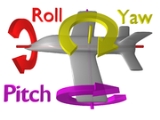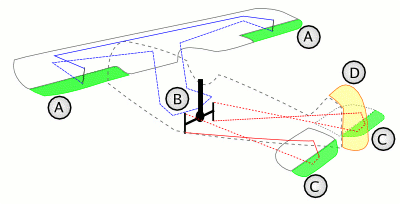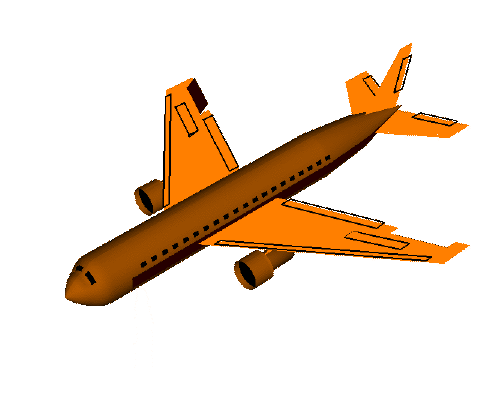
Aircraft principal axes
Encyclopedia
An aircraft
in flight is free to rotate in three dimensions: pitch, nose up or down about an axis running from wing to wing), yaw, nose left or right about an axis running up and down; and roll, rotation about an axis running from nose to tail. The axes are alternatively designated as lateral, vertical, and longitudinal. These axes move with the vehicle
, and rotate relative to the Earth along with the craft. These definitions were analogously applied to spacecraft
when the first manned spacecraft were designed in the late 1950s.
These rotations are produced by torque
s (or moment
s) about the principal axes. On an aircraft, these are produced by means of moving control surfaces, which vary the distribution of the net aerodynamic force about the vehicle's center of gravity
. Elevators (moving flaps on the horizontal tail) produce pitch, a rudder on the vertical tail produces yaw, and ailerons (moving flaps on the wings) produce roll. On a spacecraft, the moments are usually produced by a reaction control system
consisting of small rocket thrusters used to apply asymmetrical thrust on the vehicle.
Normally these axes are represented by the letters X, Y and Z in order to compare them with some reference frame, usually named x, y, z. Normally this is made in such a way that the X is used for the longitudinal axis, but there are other possibilities
to do it.
, rocket
, or similar body, about which the body yaws; it may be a body, wind, or stability axis. Also known as yawing axis.
The yaw axis is defined to be perpendicular
to the body of the wings with its origin at the center of gravity and directed towards the bottom of the aircraft. A yaw motion is a movement of the nose of the aircraft from side to side. The pitch axis is perpendicular to the yaw axis and is parallel to the body of the wings with its origin at the center of gravity
and directed towards the right wing tip. A pitch motion is an up or down movement of the nose of the aircraft. The roll axis is perpendicular to the other two axes with its origin at the center of gravity, and is directed towards the nose of the aircraft. A rolling motion is an up and down movement of the wing tips of the aircraft.

 The longitudinal axis passes through the plane from nose to tail. Rotation about this axis is called bank or roll. Bank changes the orientation of the aircraft's wings with respect to the downward force of gravity. The pilot changes bank angle by increasing the lift on one wing and decreasing it on the other. This differential lift causes bank rotation around the longitudinal axis. The ailerons are the primary control of bank. The rudder also has a secondary effect on bank.
The longitudinal axis passes through the plane from nose to tail. Rotation about this axis is called bank or roll. Bank changes the orientation of the aircraft's wings with respect to the downward force of gravity. The pilot changes bank angle by increasing the lift on one wing and decreasing it on the other. This differential lift causes bank rotation around the longitudinal axis. The ailerons are the primary control of bank. The rudder also has a secondary effect on bank.
In aeronautical and aerospace engineering intrinsic rotations around these axes are often called Euler angles
, but this conflicts with existing usage elsewhere. The calculus behind them is similar to the Frenet-Serret formulas
. Performing a rotation in an intrinsic reference frame is equivalent to right-multiply its characteristic matrix (the matrix that has the vector of the reference frame as columns) by the matrix of the rotation.
' 1902 glider.
Aircraft
An aircraft is a vehicle that is able to fly by gaining support from the air, or, in general, the atmosphere of a planet. An aircraft counters the force of gravity by using either static lift or by using the dynamic lift of an airfoil, or in a few cases the downward thrust from jet engines.Although...
in flight is free to rotate in three dimensions: pitch, nose up or down about an axis running from wing to wing), yaw, nose left or right about an axis running up and down; and roll, rotation about an axis running from nose to tail. The axes are alternatively designated as lateral, vertical, and longitudinal. These axes move with the vehicle
Moving frame
In mathematics, a moving frame is a flexible generalization of the notion of an ordered basis of a vector space often used to study the extrinsic differential geometry of smooth manifolds embedded in a homogeneous space.-Introduction:...
, and rotate relative to the Earth along with the craft. These definitions were analogously applied to spacecraft
Spacecraft
A spacecraft or spaceship is a craft or machine designed for spaceflight. Spacecraft are used for a variety of purposes, including communications, earth observation, meteorology, navigation, planetary exploration and transportation of humans and cargo....
when the first manned spacecraft were designed in the late 1950s.
These rotations are produced by torque
Torque
Torque, moment or moment of force , is the tendency of a force to rotate an object about an axis, fulcrum, or pivot. Just as a force is a push or a pull, a torque can be thought of as a twist....
s (or moment
Moment (physics)
In physics, the term moment can refer to many different concepts:*Moment of force is the tendency of a force to twist or rotate an object; see the article torque for details. This is an important, basic concept in engineering and physics. A moment is valued mathematically as the product of the...
s) about the principal axes. On an aircraft, these are produced by means of moving control surfaces, which vary the distribution of the net aerodynamic force about the vehicle's center of gravity
Center of gravity
In physics, a center of gravity of a material body is a point that may be used for a summary description of gravitational interactions. In a uniform gravitational field, the center of mass serves as the center of gravity...
. Elevators (moving flaps on the horizontal tail) produce pitch, a rudder on the vertical tail produces yaw, and ailerons (moving flaps on the wings) produce roll. On a spacecraft, the moments are usually produced by a reaction control system
Reaction control system
A reaction control system is a subsystem of a spacecraft whose purpose is attitude control and steering by the use of thrusters. An RCS system is capable of providing small amounts of thrust in any desired direction or combination of directions. An RCS is also capable of providing torque to allow...
consisting of small rocket thrusters used to apply asymmetrical thrust on the vehicle.
The three Aircraft principal axes
- Vertical axis, or yaw axis — an axis drawn from top to bottom, and perpendicular to the other two axes. Parallel to the fuselage station.
- Lateral axis, transverse axis, or pitch axis — an axis running from the pilot's left to right in piloted aircraft, and parallel to the wings of a winged aircraft. Parallel to the buttock line.
- Longitudinal axis, or roll axis — an axis drawn through the body of the vehicle from tail to nose in the normal direction of flight, or the direction the pilot faces. Parallel to the waterlineWaterlineThe term "waterline" generally refers to the line where the hull of a ship meets the water surface. It is also the name of a special marking, also known as the national Load Line or Plimsoll Line, to be positioned amidships, that indicates the draft of the ship and the legal limit to which a ship...
.
Normally these axes are represented by the letters X, Y and Z in order to compare them with some reference frame, usually named x, y, z. Normally this is made in such a way that the X is used for the longitudinal axis, but there are other possibilities
Axes conventions
Mobile objects are normally tracked from an external frame considered fixed. Other frames can be defined on those mobile objects to deal with relative positions for other objects. Finally, attitudes or orientations can be described by a relationship between the external frame and the one defined...
to do it.
Vertical axis (yaw)
Yaw axis is a vertical axis through an aircraftAircraft
An aircraft is a vehicle that is able to fly by gaining support from the air, or, in general, the atmosphere of a planet. An aircraft counters the force of gravity by using either static lift or by using the dynamic lift of an airfoil, or in a few cases the downward thrust from jet engines.Although...
, rocket
Rocket
A rocket is a missile, spacecraft, aircraft or other vehicle which obtains thrust from a rocket engine. In all rockets, the exhaust is formed entirely from propellants carried within the rocket before use. Rocket engines work by action and reaction...
, or similar body, about which the body yaws; it may be a body, wind, or stability axis. Also known as yawing axis.
The yaw axis is defined to be perpendicular
Perpendicular
In geometry, two lines or planes are considered perpendicular to each other if they form congruent adjacent angles . The term may be used as a noun or adjective...
to the body of the wings with its origin at the center of gravity and directed towards the bottom of the aircraft. A yaw motion is a movement of the nose of the aircraft from side to side. The pitch axis is perpendicular to the yaw axis and is parallel to the body of the wings with its origin at the center of gravity
Center of gravity
In physics, a center of gravity of a material body is a point that may be used for a summary description of gravitational interactions. In a uniform gravitational field, the center of mass serves as the center of gravity...
and directed towards the right wing tip. A pitch motion is an up or down movement of the nose of the aircraft. The roll axis is perpendicular to the other two axes with its origin at the center of gravity, and is directed towards the nose of the aircraft. A rolling motion is an up and down movement of the wing tips of the aircraft.

Lateral axis (pitch)
The lateral axis passes through the plane from wingtip to wingtip. Rotation about this axis is called pitch. Pitch changes the vertical direction the aircraft's nose is pointing. The elevators are the primary control of pitch. Also called Transverse axis.Longitudinal axis (roll)

Relationship with other systems of axes
These axes are related to the principal axes of inertia, but are not the same. They are geometrical symmetry axes, regardless of the mass distribution of the aircraft.In aeronautical and aerospace engineering intrinsic rotations around these axes are often called Euler angles
Euler angles
The Euler angles are three angles introduced by Leonhard Euler to describe the orientation of a rigid body. To describe such an orientation in 3-dimensional Euclidean space three parameters are required...
, but this conflicts with existing usage elsewhere. The calculus behind them is similar to the Frenet-Serret formulas
Frenet-Serret formulas
In vector calculus, the Frenet–Serret formulas describe the kinematic properties of a particle which moves along a continuous, differentiable curve in three-dimensional Euclidean space R3...
. Performing a rotation in an intrinsic reference frame is equivalent to right-multiply its characteristic matrix (the matrix that has the vector of the reference frame as columns) by the matrix of the rotation.
History
The first aircraft to demonstrate active control about all three axes was the Wright brothersWright brothers
The Wright brothers, Orville and Wilbur , were two Americans credited with inventing and building the world's first successful airplane and making the first controlled, powered and sustained heavier-than-air human flight, on December 17, 1903...
' 1902 glider.
See also
- Aerodynamic
- Euler anglesEuler anglesThe Euler angles are three angles introduced by Leonhard Euler to describe the orientation of a rigid body. To describe such an orientation in 3-dimensional Euclidean space three parameters are required...
- Fixed-wing aircraftFixed-wing aircraftA fixed-wing aircraft is an aircraft capable of flight using wings that generate lift due to the vehicle's forward airspeed. Fixed-wing aircraft are distinct from rotary-wing aircraft in which wings rotate about a fixed mast and ornithopters in which lift is generated by flapping wings.A powered...
- Flight control surfaces
- Flight dynamicsFlight dynamicsFlight dynamics is the science of air vehicle orientation and control in three dimensions. The three critical flight dynamics parameters are the angles of rotation in three dimensions about the vehicle's center of mass, known as pitch, roll and yaw .Aerospace engineers develop control systems for...
- Moving frameMoving frameIn mathematics, a moving frame is a flexible generalization of the notion of an ordered basis of a vector space often used to study the extrinsic differential geometry of smooth manifolds embedded in a homogeneous space.-Introduction:...
- Screw theoryScrew theoryScrew theory refers to the algebra and calculus of pairs of vectors, such as forces and moments and angular and linear velocity, that arise in the kinematics and dynamics of rigid bodies....
- Triad MethodTriad MethodThe Triad Method, also known as the algebraic method, is a method for calculating the inclination of an object based on two known vectors in relation to that object's axis system. It was developed in 1964 by Harold D. Black and first published in the Journal of the American Institute of Aeronautics...

